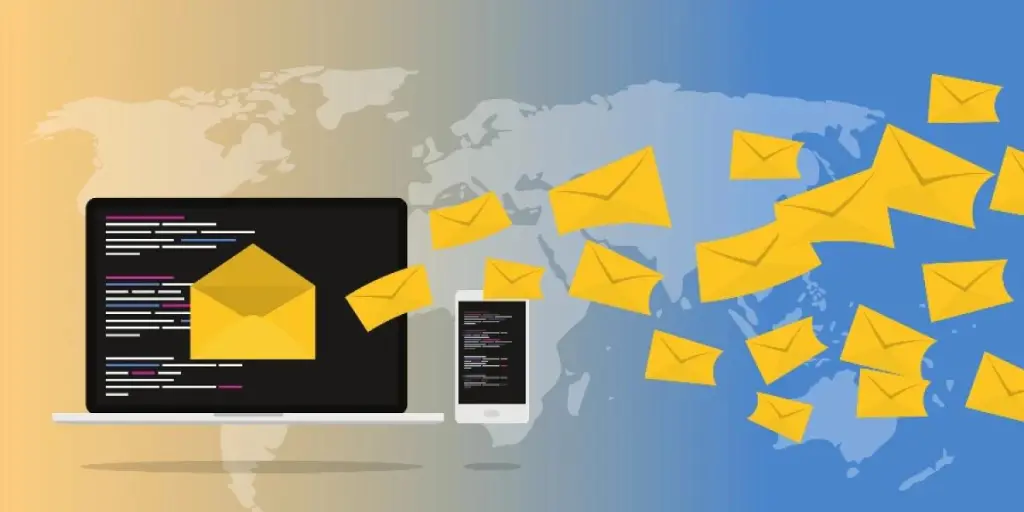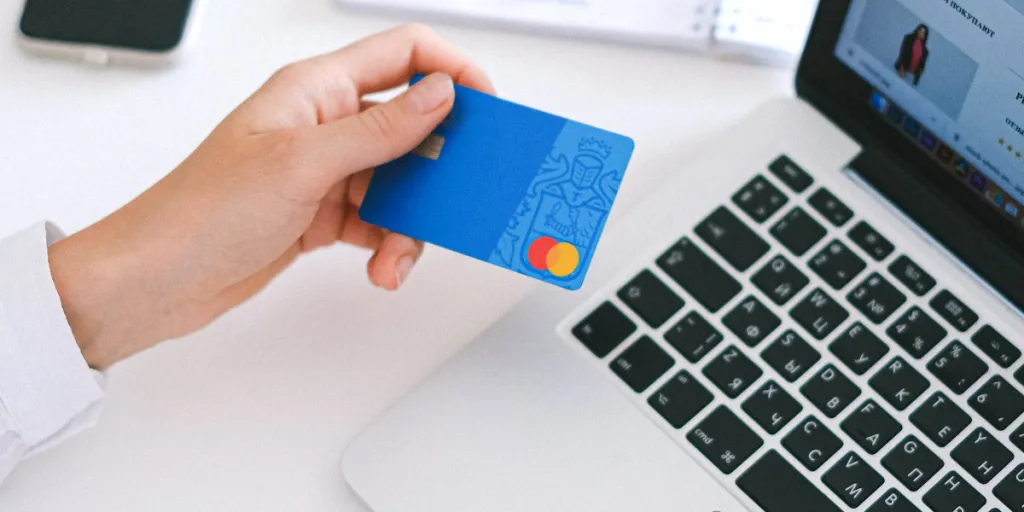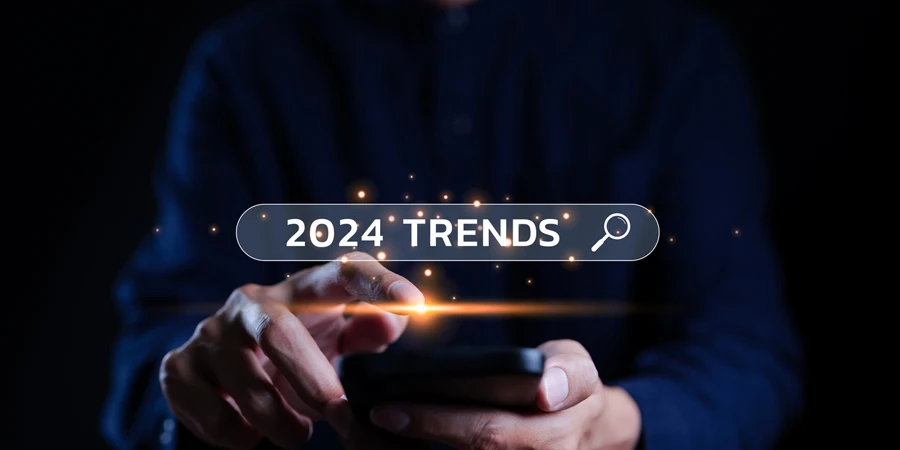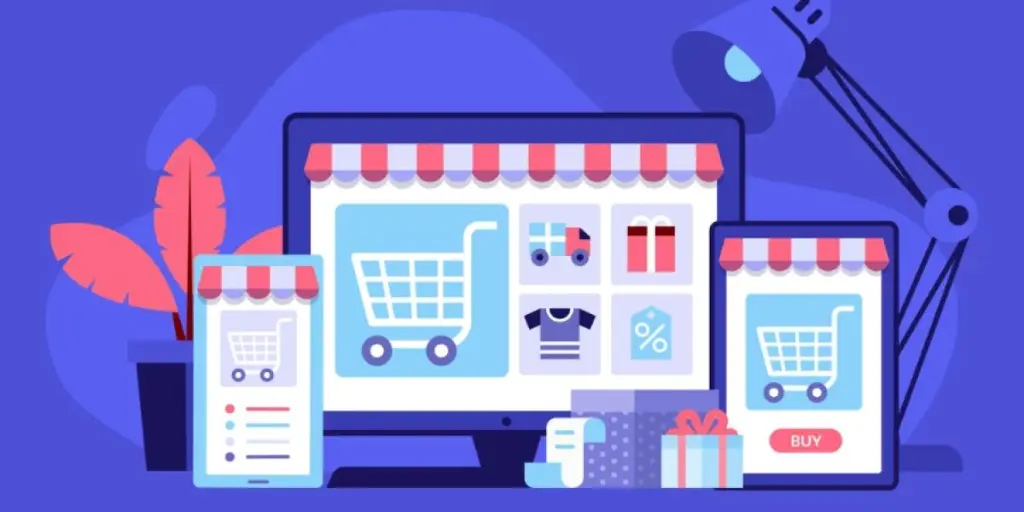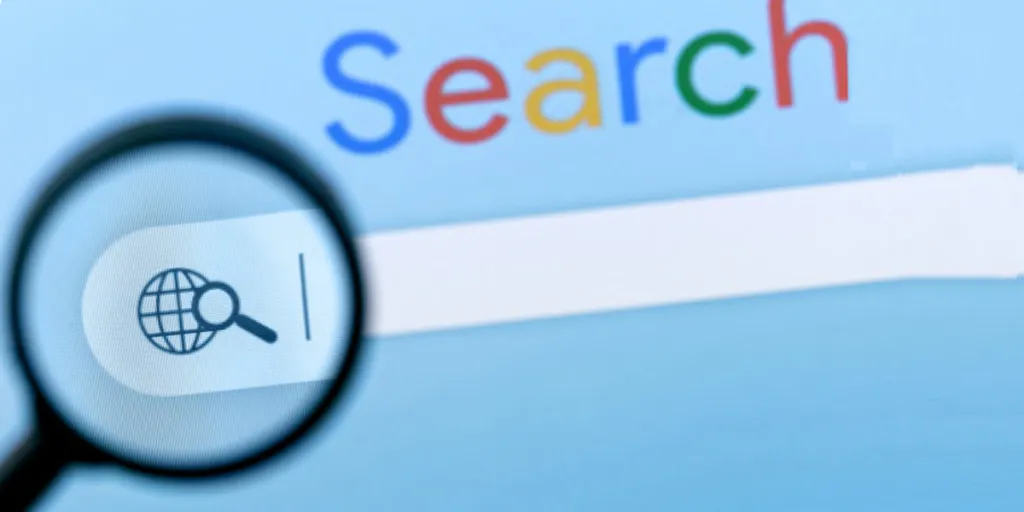Many marketers think that sending lots of emails to a big group of people is the best way to get their attention and make them interested.
But just sending general messages might not work as well as they hope.
In reality, personalization is the need of the hour, with customers preferring tailored experiences. A Twilio Segment study found that 62% of customers consider personalization important to remain loyal to a brand. The report says that almost half (49%) of customers will probably keep coming back if they get special experiences just for them.
This article will show you real examples of customer segmentation, so you can use it yourself to drive new revenue.
In this article, we’ll explore:
What is customer segmentation?
Customer segmentation involves dividing users into smaller groups for effective targeting. The variables used for segmentation include demographics, online behavior, geographic data, etc.
Using segmentation, marketers can talk to specific groups of people and send the right message at the perfect time, instead of sending one message to everybody.
Customer segmentation models
There are four main types of customer segmentation, each with the potential to work in different ways. These include:
Behavioral segmentation
Behavioral segmentation divides customers based on their behavior whilst on a website. It can include their purchases, what they look at, and whether they respond to popups or explore the site via website banners.
The main features that behavioral segmentation considers are:
- Interest: What interests the customer and what brought them to a website in the first place. This can range from the specialty of the website to the specific products it sells.
- Usage: How long the customer spends on the website and how often they visit or buy from it.
- Occasion: Besides what they like, what other things or special times have made customers go to a website? This can be for different events during the year, like a big sale on Black Friday.
- Engagement: How a customer interacts with a website, whether they respond to popups and other elements.
- Loyalty: The unique features that make customers loyal to a website. This can include those that interact with loyalty programs or VIP tiers.
Geographic segmentation
Geographic segmentation involves segmenting an audience based on location.
The five main factors for geographic segmentation are:
- Primary location: The country, state, city, or even ZIP code of your customers.
- Cultural preferences: Merchants should always consider cultural preferences when marketing. Failing to do so could result in losing opportunities or even backlash.
- Language: Marketers can also segment their users based on their language. If your target users speak different languages, factor this into your marketing.
- Population type: This includes the density of the population a brand targets. It considers whether a business markets to urban, suburban, or rural audiences.
Psychographic segmentation
This way of grouping tries to separate customers into different groups based on factors that affect their buying decisions.
These include:
- Personality: Some brands or products make certain types of people feel more connected to them. For example, if you’re a happy and positive person, you might respond to marketing messages with emojis.
- Lifestyles: Certain brands and products fit different lifestyles. For example, some brands identify as luxury and appeal to wealthy consumers.
- Values and attitudes: Marketers can also segment customers based on their values and mindset. For example, some customers resonate with cause marketing.
Demographic segmentation
Demographic segmentation groups potential and existing customers via more universal traits such as:
- Age: You can divide customers by age groups, not just specific ages. For example, 18 to 25 will typically look at young adult audiences.
- Gender: You can divide customers based on whether they identify as male, female, or gender fluid.
- Ethnicity and/or religion: Certain products appeal more to customers who come from specific ethnic or religious backgrounds. For example, some customers might wish to shop for halal or kosher products.
- Education: Some brands make product recommendations based on the education level of the customers.
- Income: Certain products, services, or brands are preferred by people who have more money. Similarly, some brands position themselves as more affordable or offering value for money.
- Occupation: People who work in different jobs might like certain brands or products more than others. The same goes for people at different stages in their career.
- Family: Certain products or services may be suitable for customers with families, such as child-friendly items.
Customer segmentation examples
Let’s take a look at some customer segmentation examples that show how brands group and target their users.
1. New newsletter subscribers
Segmentation category: Behavioral
The new subscriber segment consists of users who have recently subscribed to a brand’s newsletters. These users anticipate receiving useful information about the brand’s products and services.
You can engage such users by first welcoming them to your brand. You can then use automation to deliver helpful content.
The image below shows a welcome email sent to users who subscribe to Reternity’s newsletter. The email welcomes the subscriber and briefly captures what they can expect from the brand.

2. Website activity
Segmentation category: Behavioral
You can segment your subscribers based on their actions on your website.
Suppose a subscriber leaves your store without checking the items in their cart. In this case, you can send an email that encourages them to complete their purchase.
Here’s an example from Island Olive Oil:
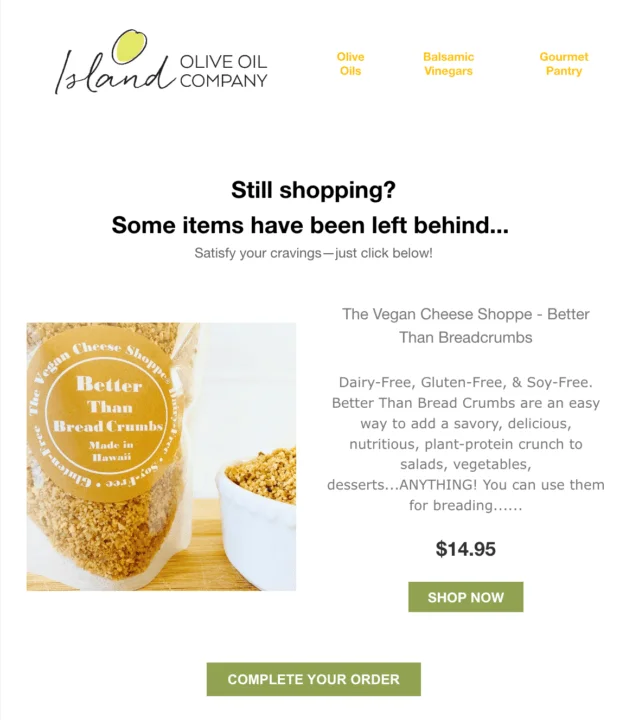
This is a good customer segmentation example and an effective way to use email marketing for ecommerce. The email is specifically targeted to the user and includes the contents of their cart.
The lifecycle stage map is an incredible opportunity for a small business. This is the kind of thing that, otherwise, takes a marketing team to be able to do. It’s a simple way to see our customers’ shopping or purchasing habits in one place, and it’s helped us to be able to target different groups.
Angèl Foster, Co-owner of Island Olive Oil Company
3. New customers
Segmentation category: Demographic
This is one of the most popular customer segmentation examples. When you buy something for the first time, companies should find effective ways to engage with you, so you’ll want to buy from them again in the future.
How would you approach a customer who falls in this customer segment? This product recommendation email provides a glimpse of how to engage new customers. You can show them other products they can get from the store to encourage more purchases.

4. Repeat customers
Segmentation category: Behavioral
In this example, we group loyal customers who trust our brand more than other companies. We send them emails suggesting products that they might want to buy next, based on past purchases. This way of grouping customers works really well because it helps us identify and reach people who often buy similar products. Here’s an example from MVMT:

5. Passive subscribers
Segmentation category: Behavioral
When customers haven’t bought anything from your store for a long time, you can send them messages that aim to bring them back. Candle Delirium does this to bring back customers who haven’t been active, and offer special discounts and offers.
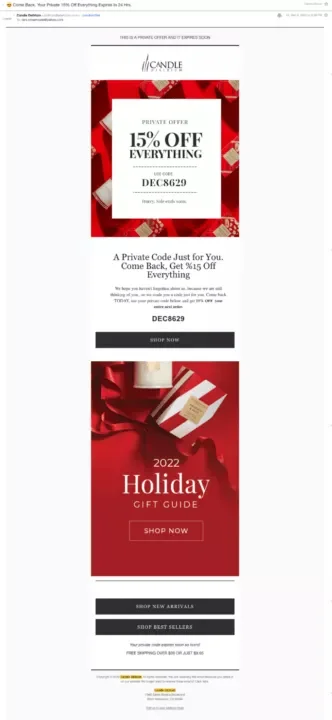
6. Loyal customers
Segmentation category: Behavioral
To say thank you, stores may find the customers who have been loyal and give them a special reward. For example, NOTIQ offers loyalty customers a special discount. This is a good way to make more sales and show your appreciation.
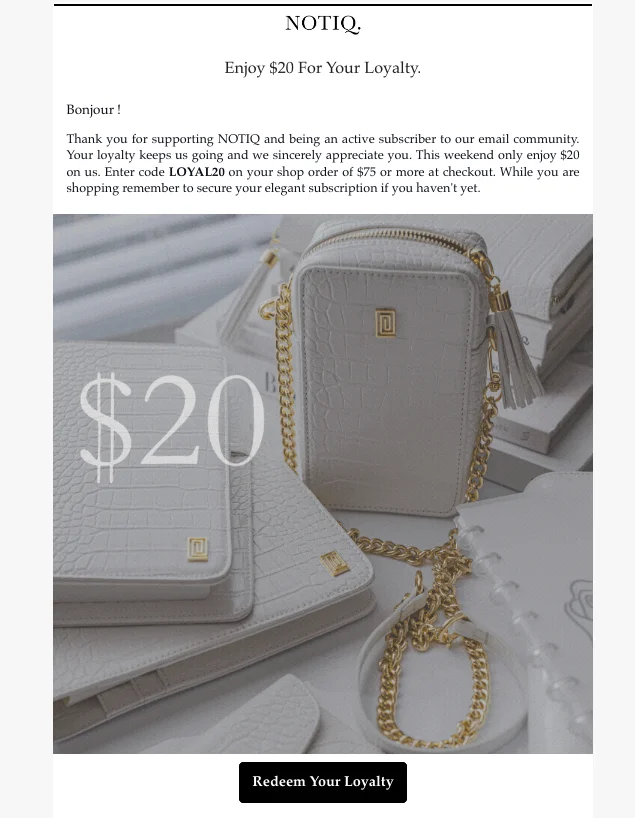
7. High potential
Segmentation category: Demographic
Marketers often group customers based on their income. This is a type of demographic segmentation. You can find the people who earn a lot of money in your audience and suggest things that they might like. Here’s a good example from Crown & Caliber, who presented valuable items to this segment:

8. Birthday
Segmentation category: Demographics
Birthdays provide brands with an excellent opportunity to segment their customers. On a customer’s birthday, the brand can wish the user well and send them appropriate offers. Automated email software makes it easy for you to send personalized birthday messages to users.
For example, Timberland used this customer segmentation strategy to engage with its subscribers. They offered personalized recommendations to make their birthdays extra special, and enhance their experience with the brand:
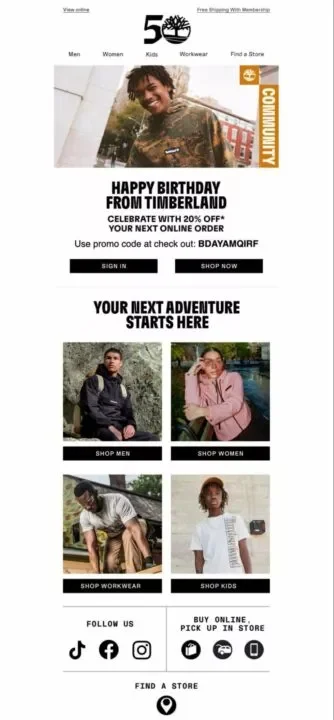
9. “At-risk”
Segmentation category: Psychographic
Are there any users in your email list who might need a little extra attention? Put them in one group and send them messages that will help them. Swanson does this in the example below.
The brand has created a segment of women with digestive problems, then sends useful information and special offers to help them:

10. Profession
Segmentation category: Demographic
In the email below, B-Wear used a smart strategy for their marketing campaign. They divided their audience based on their job, focusing on teachers.
To get teachers interested, B-Wear began by creating an email that showcased the special advantages and qualities of their products, designed specifically for educators. They emphasized how their clothing items are durable, comfortable, and practical—essential for teachers who are always on their feet, working with students, and moving around busy school settings.

11. Milestones
Segmentation category: Behavioral
Brands can also group users who have reached important milestones, like an anniversary or being a loyal customer for a year. They can then send them messages to celebrate their achievements.
For example, Huckberry keeps track of when users sign up for their newsletter and sends them special offers on their anniversary:
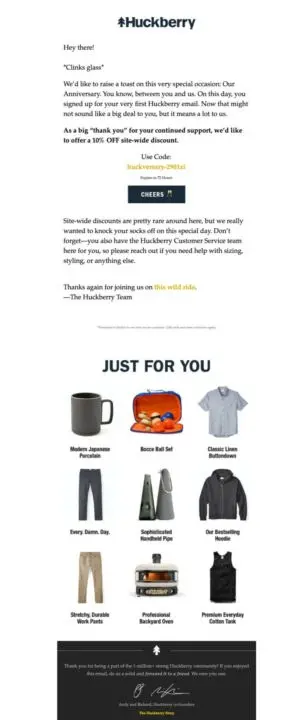
12. Gender
Segmentation category: Demographic
Gender is a popular segmentation option for brands that don’t solely cater to men or women. The image below shows how Proozy segments female subscribers and recommends relevant products:

13. Location
Segmentation category: Geographic
Segmenting your audience by location is a highly effective way to reach specific people, particularly if you have a retail store, special event, or other physical presence. It’s also effective if you a location has particular requirements—such as warm weather clothing in colder climates. In the example below, Amundsen Sports sends an email about their brand store in that region.

14. Values
Segmentation category: Psychographic
Here is a great example of grouping customers based on how they think and feel. If you know what your customers care about, you can segment them accordingly. To’ak Chocolate knows that many of its customers care about products that are sourced in a sustainable way. When they send out their newsletter, they send messages that show how committed they are to making products in an eco-friendly way.
This makes people trust and like To’ak Chocolate even more, developing brand loyalty, and ultimately showing how marketing campaigns can be more meaningful and have a bigger impact.
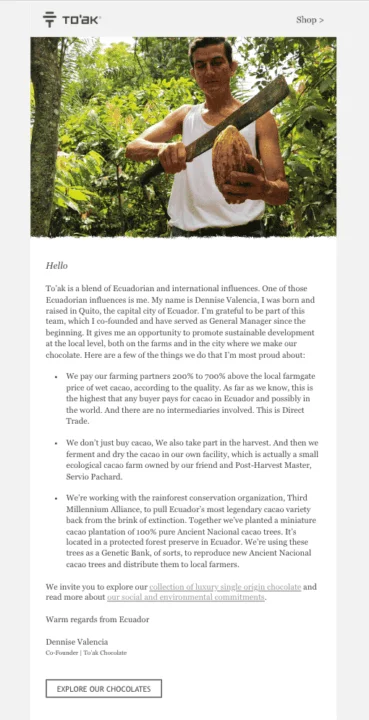
15. Interests & hobbies
Segmentation category: Psychographic
Lastly, here is a customer segmentation example based on a user’s interests. Minimalist Baker targeted subscribers identified as vegan with this email. The email shares a quick Korean-inspired vegan cabbage recipe. This is hyper-relevant to the recipients, which increases the likelihood of the audience opening future emails and making purchases from the company:
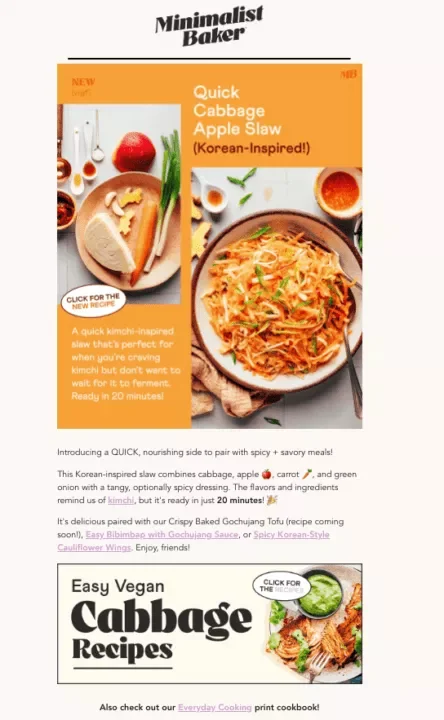
Summary
Effective customer segmentation can lead to exceptional customer satisfaction. Shoppers want to receive messages that are personal to them, and segmentation takes personalization to the next level.
Begin by identifying a few basic groups of customers, and as you discover better ways to connect with your audience, you can include more segments.
With the right platform, marketing can be made easy.
Source from Omnisend
Disclaimer: The information set forth above is provided by Omnisend independently of Alibaba.com. Alibaba.com makes no representation and warranties as to the quality and reliability of the seller and products.
